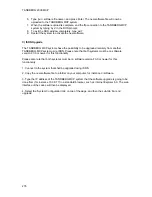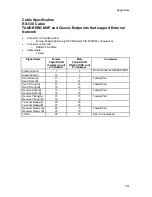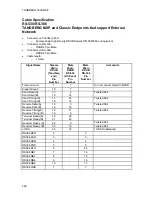
TANDBERG 2000 MXP
280
Appendix 18: Protocols Supported
PROTOCOLS SUPPORTED
TCP/IP - Transmission Control Protocol/Internet Protocol
A set of networking protocols that provides connectivity over LAN/WAN to any network computer.
HTTP - Hypertext Transfer Protocol
A protocol used to transfer information on the internet. A web-browser interface is used to access
the management computer. (Max number of simultaneous connections is unlimited, although only
one is processed at a time).
HTTPS - Hypertext Transfer Protocol Secure sockets
If a Web server supports the SSL protocol (establish a secure communications channel to
prevent the interception of critical information), the Internet address for the server will begin with
https:// instead of http://
FTP - File Transfer Protocol
A member of the TCP/IP suite of protocols used to copy files between two computers on the
Internet. FTP provides standard method for remote software upgrades. (Max. number of
simultaneous connection = 1).
TELNET
Telnet provides access to management functions by using a standard command-line interface.
(Max. number of simultaneous connection = 8, in addition to the RS232 connection).
TELNET Challenge
TMS (Tandberg Management Suite) uses MD5-Challenge Response algorithm (RFC-1321)
Telnet access for encryption of password over the IP network.
SNMP - Simple Network Management Protocol
A standard network protocol for management and surveillance of TCP/IP networks (RFC 1157
SNMP v1, RFC 1213 MIB-II).
DHCP - Dynamic Host Configuration Protocol
DHCP is a TCP/IP protocol that offers dynamic IP addresses and other configuration parameters
(subnet mask) to network clients. It provides safe reliable and simple network configuration,
prevents address conflicts, and helps conserve the use of client IP addresses.
DNS - Domain Name System
A hierarchical distributed database that contains mappings of DNS domain names to various
types of data, such as IP addresses. DNS enables the location of computers and services by
user-friendly names, and it also enables the discovery of other information stored in the database.
Network Protocol – Is a set of rules and conventions for sending information over a
communications network. These rules govern the content, format, timing, sequencing, and error
control of messages exchanged among network devices.
LAN – Local Area Network
A communications network connecting a group of computers, printers, and other devices located
within a relatively limited area (for example, a building).
Содержание 2000 MXP
Страница 14: ......
Страница 24: ...TANDBERG 2000 MXP 10 2 1 Mounting When mounting the TANDBERG 2000 MXP follow the figures below ...
Страница 195: ...Administrator Settings 181 Voice Switched mode ...
Страница 202: ...TANDBERG 2000 MXP 188 5 8 Network The network menu contain ISDN BRI Settings LAN Settings Network Profiles Data Port ...
Страница 247: ...Peripheral Equipment 233 ...
Страница 249: ...Peripheral Equipment 235 6 9 Dual Monitor Note that this requires a system with dual monitor video output ...
Страница 273: ...Appendices 259 ...
Страница 277: ...Appendices 263 Top view ...
Страница 279: ...Appendices 265 Pin 5 GND Pin 4 RXD in Pin 3 TXD out Pin 2 Presence 12V in daisy chain Pin 1 GND ...
Страница 280: ...TANDBERG 2000 MXP 266 Dimensions Front view Side view Rear view Underside view ...
Страница 288: ...TANDBERG 2000 MXP 274 Figure 1 3 Enter the Release key in the Release Key field and press the Install Software button ...
















































